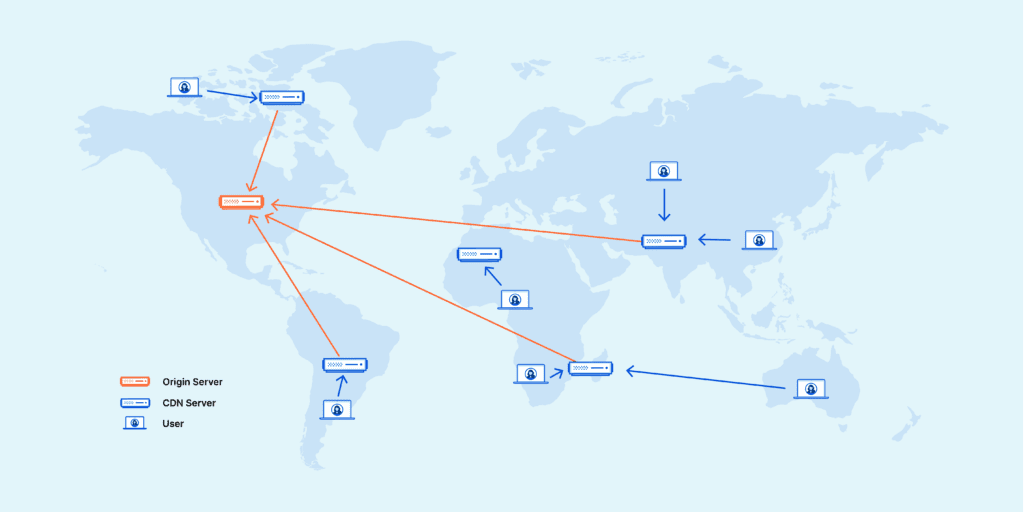
In the age of digital media, Over-The-Top (OTT) platforms like Amazon Prime Video, Netflix, and Hotstar have revolutionized the way we consume content. These platforms deliver a vast array of movies, TV shows, and exclusive content directly to our devices, bypassing traditional broadcast and cable systems. But what technology runs behind these OTT platforms, and how do they ensure millions of users can watch their favorite shows without any hiccups? Let’s dive into what powers these OTT platforms, how they ensure a smooth, uninterrupted viewing experience for millions of users, and the advantages this advanced technology offers.
The Technology Behind OTT Platforms
1. Content Delivery Networks (CDNs)
CDNs are a critical component of OTT platforms, ensuring that content is delivered swiftly and reliably to users worldwide. CDNs work by distributing content across a network of servers in various geographical locations. This minimizes latency and ensures that users receive content from a server that is geographically close to them. Imagine trying to stream a movie that’s stored on a server halfway across the world—it would be painfully slow! That’s where CDNs come in.
- What They Do: CDNs distribute content across a network of servers located in different regions. This reduces the distance data has to travel, ensuring faster load times and less buffering.
- Popular CDNs: Akamai, Cloudflare, Amazon CloudFront
- Advantage: Faster streaming and reduced buffering make for a more enjoyable viewing experience.

2. Video Encoding and Transcoding
To deliver high-quality video to a variety of devices, OTT platforms employ video encoding and transcoding. Encoding converts raw video files into digital formats, while transcoding adapts these files to different resolutions and bitrates suitable for various devices and internet speeds. Not all devices and internet connections are created equal. OTT platforms need to cater to everything from high-speed broadband connections to mobile data.
- Encoding: Converts raw video files into digital formats.
- Transcoding: Adapts these digital files to different resolutions and bitrates, making them suitable for various devices and internet speeds.
- Common Codecs: H.264, H.265 (HEVC), VP9
- Advantage: Ensures compatibility across various devices and network conditions, providing a consistent viewing experience.
3. Adaptive Bitrate Streaming (ABR)
Adaptive Bitrate Streaming (ABR) ensures smooth playback by dynamically adjusting the video quality based on the user’s current internet speed and device capabilities. This technology enables platforms to deliver the best possible viewing experience, reducing buffering and interruptions. Ever noticed how the video quality adjusts when your internet connection fluctuates? That’s ABR in action.
- Protocols: HLS (HTTP Live Streaming), MPEG-DASH
- Advantage: Reduces buffering and interruptions, offering a smoother viewing experience.
4. Cloud Infrastructure
OTT platforms leverage robust cloud infrastructure to store, process, and distribute content. Cloud providers like Amazon Web Services (AWS), Google Cloud Platform (GCP), and Microsoft Azure offer scalable solutions that handle the high demand for video streaming. OTT platforms need massive amounts of storage and computational power to manage their vast libraries of content.
- Benefits: Scalability, flexibility, and reliability to handle high demand.
- Advantage: Easily scalable to handle increasing user demands and content libraries, providing reliable and continuous service.
5. Microservices Architecture
A microservices architecture allows OTT platforms to break down their applications into smaller, independent services. Each service handles a specific function, such as user authentication, content recommendation, or payment processing. This architecture promotes scalability, resilience, and ease of maintenance. Instead of one large application, OTT platforms use a “microservices” approach.
- What It Means: The platform is broken down into smaller, independent services. Each service handles a specific function like user authentication, video streaming, or billing.
- Benefits: Easier to manage, scale, and update without affecting other parts of the platform.
- Advantage: Enhances scalability, maintenance, and rapid deployment of new features.
The Architecture of OTT Platforms
The architecture of OTT platforms is designed to support millions of concurrent users, ensure high availability, and deliver content with minimal latency. Here’s a high-level overview of a typical OTT platform architecture:
1. Ingestion and Encoding
- Content Ingestion: Content is uploaded by providers and ingested into the system. This could include raw video files, metadata, and subtitles.
- Encoding/Transcoding: The ingested content is encoded and transcoded into various formats and bitrates. This allows the content to be streamed on different devices with varying network conditions.
2. Storage and Content Management
- Storage: Encoded content is stored in a distributed storage system, such as Amazon S3 or Google Cloud Storage.
- Content Management System (CMS): Manages metadata, user entitlements, and content workflows. The CMS ensures that content is organized, searchable, and accessible to the delivery system.
3. Content Delivery
- Content Delivery Networks (CDNs): Cached copies of content are distributed across CDNs to ensure fast delivery. CDNs help in reducing the load on origin servers and minimize latency by serving content from the closest edge server to the user.
4. Streaming and Playback
- Streaming Servers: Handle the distribution of content to users. These servers support protocols like HLS (HTTP Live Streaming) and DASH (Dynamic Adaptive Streaming over HTTP) for adaptive bitrate streaming.
- Playback Applications: The client-side applications (web, mobile, smart TV) that users interact with to browse, select, and play content. These applications communicate with the streaming servers to fetch and play the content.
5. User Management and Authentication
- Authentication Services: Ensure secure access to the platform using various authentication mechanisms like OAuth, token-based authentication, etc.
- User Profiles: Manage user preferences, watch history, and personalized recommendations.
6. Monitoring and Analytics
- Monitoring Tools: Track system performance, server health, and content delivery metrics. Tools like Prometheus and Grafana are commonly used.
- Analytics: Collect data on user behavior, content popularity, and platform usage. This data helps in making informed decisions about content acquisition and platform improvements.
The Role of DevOps in OTT Platforms
DevOps practices are essential for maintaining the seamless operation of OTT platforms. By fostering a culture of collaboration between development and operations teams, DevOps ensures rapid, reliable, and continuous delivery of high-quality software. Here’s how DevOps contributes to the success of OTT platforms:
1. Continuous Integration and Continuous Deployment (CI/CD)
CI/CD pipelines automate the process of integrating code changes, running tests, and deploying new features or updates to production. This automation minimizes manual errors, accelerates release cycles, and ensures that new content or features are delivered to users without downtime.
- How It Helps: Automates code integration and deployment, ensuring new features and updates are delivered quickly and reliably.
- Tools Used: Jenkins, GitLab CI
2. Infrastructure as Code (IaC)
IaC tools like Terraform and AWS CloudFormation allow teams to manage and provision infrastructure using code. This approach ensures consistency, reduces configuration errors, and makes it easier to scale resources up or down based on demand.
- How It Helps: Manages infrastructure through code, making it easy to provision and scale resources.
3. Monitoring and Logging
Robust monitoring and logging systems are crucial for maintaining the health and performance of OTT platforms. Tools like Prometheus, Grafana, and ELK Stack (Elasticsearch, Logstash, Kibana) provide real-time insights into system performance, enabling teams to quickly identify and resolve issues.
4. Automated Testing
Automated testing ensures that new code changes do not introduce bugs or regressions. Unit tests, integration tests, and end-to-end tests verify that each component of the platform functions as expected, maintaining high-quality user experiences.
- How It Ensures Quality: Runs tests automatically to catch bugs and performance issues before code is deployed.
5. Scalability and Load Balancing
To handle millions of concurrent users, OTT platforms must be highly scalable. Load balancers distribute incoming traffic across multiple servers, preventing any single server from becoming overwhelmed. Autoscaling mechanisms dynamically adjust the number of running instances based on current demand, ensuring that resources are used efficiently.
- Why It’s Crucial: To handle millions of users, OTT platforms must be scalable. Load balancers distribute traffic evenly across servers.
Conclusion
The seamless experience of streaming your favorite show on Amazon Prime Video, Netflix, or Hotstar is the result of sophisticated technologies, a robust architecture, and meticulous DevOps practices working in harmony. CDNs, video encoding, ABR, cloud infrastructure, and microservices architecture form the backbone of these platforms. Meanwhile, DevOps practices like CI/CD, IaC, monitoring, automated testing, and scalability ensure that these systems run smoothly, delivering high-quality content to millions of users around the globe. As technology continues to evolve, we can expect even more innovation in the OTT space, enhancing our viewing experiences further.
